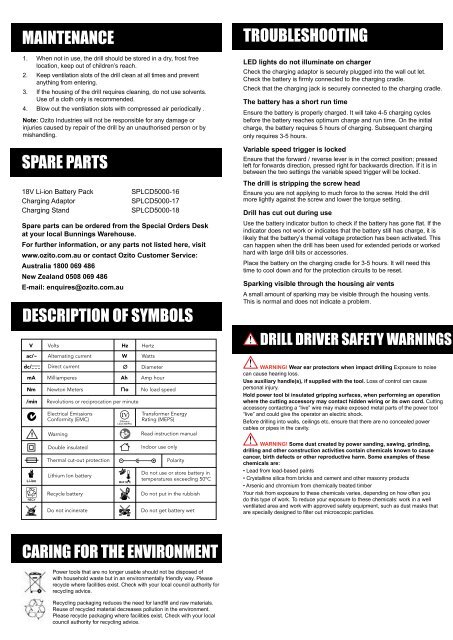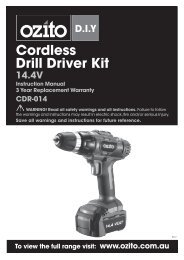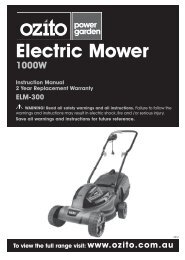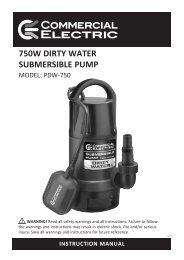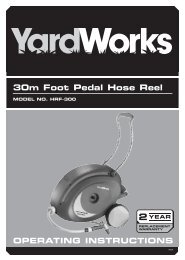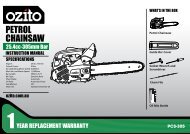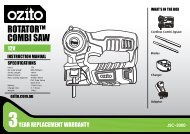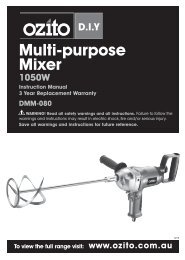CORDLESS DRILL DRIVER
CORDLESS DRILL DRIVER
CORDLESS DRILL DRIVER
- No tags were found...
You also want an ePaper? Increase the reach of your titles
YUMPU automatically turns print PDFs into web optimized ePapers that Google loves.
MAINTENANCE1. When not in use, the drill should be stored in a dry, frost freelocation, keep out of children’s reach.2. Keep ventilation slots of the drill clean at all times and preventanything from entering.3. If the housing of the drill requires cleaning, do not use solvents.Use of a cloth only is recommended.4. Blow out the ventilation slots with compressed air periodically .Note: Ozito Industries will not be responsible for any damage orinjuries caused by repair of the drill by an unauthorised person or bymishandling.SPARE PARTS18V Li-ion Battery PackCharging AdaptorCharging StandSpare parts can be ordered from the Special Orders Deskat your local Bunnings Warehouse.For further information, or any parts not listed here, visitwww.ozito.com.au or contact Ozito Customer Service:Australia 1800 069 486New Zealand 0508 069 486E-mail: enquires@ozito.com.auDESCRIPTION OF SYMBOLSV Volts Hz Hertzac/~ Alternating current W Wattsdc/ Direct currentDiametermA/minMilliamperesWarningDouble insulatedThermal cut-out protectionRecycle batteryDo not incinerateøAhRevolutions or reciprocation per minuteElectrical EmissionsConformity (EMC)Lithium Ion batterySPLCD5000-16SPLCD5000-17SPLCD5000-18Amp hourNm Newton Meters no No load speedTransformer EnergyRating (MEPS)Read instruction manualIndoor use onlyPolarityDo not use or store battery intemperatures exceeding 50ºCDo not put in the rubbishDo not get battery wetTROUBLESHOOTINGLED lights do not illuminate on chargerCheck the charging adaptor is securely plugged into the wall out let.Check the battery is firmly connected to the charging cradle.Check that the charging jack is securely connected to the charging cradle.The battery has a short run timeEnsure the battery is properly charged. It will take 4-5 charging cyclesbefore the battery reaches optimum charge and run time. On the initialcharge, the battery requires 5 hours of charging. Subsequent chargingonly requires 3-5 hours.Variable speed trigger is lockedEnsure that the forward / reverse lever is in the correct position; pressedleft for forwards direction, pressed right for backwards direction. If it is inbetween the two settings the variable speed trigger will be locked.The drill is stripping the screw headEnsure you are not applying to much force to the screw. Hold the drillmore lightly against the screw and lower the torque setting.Drill has cut out during useUse the battery indicator button to check if the battery has gone flat. If theindicator does not work or indicates that the battery still has charge, it islikely that the battery’s themal voltage protection has been activated. Thiscan happen when the drill has been used for extended periods or workedhard with large drill bits or accessories.Place the battery on the charging cradle for 3-5 hours. It will need thistime to cool down and for the protection circuits to be reset.Sparking visible through the housing air ventsA small amount of sparking may be visible through the housing vents.This is normal and does not indicate a problem.<strong>DRILL</strong> <strong>DRIVER</strong> SAFETY WARNINGSWARNING! Wear ear protectors when impact drilling Exposure to noisecan cause hearing loss.Use auxiliary handle(s), if supplied with the tool. Loss of control can causepersonal injury.Hold power tool bi insulated gripping surfaces, when performing an operationwhere the cutting accessory may contact hidden wiring or its own cord. Cuttingaccessory contacting a “live” wire may make exposed metal parts of the power tool“live” and could give the operator an electric shock.Before drilling into walls, ceilings etc, ensure that there are no concealed powercables or pipes in the cavity.WARNING! Some dust created by power sanding, sawing, grinding,drilling and other construction activities contain chemicals known to causecancer, birth defects or other reproductive harm. Some examples of thesechemicals are:• Lead from lead-based paints• Crystalline silica from bricks and cement and other masonry products• Arsenic and chromium from chemically treated timberYour risk from exposure to these chemicals varies, depending on how often youdo this type of work. To reduce your exposure to these chemicals: work in a wellventilated area and work with approved safety equipment, such as dust masks thatare specially designed to filter out microscopic particles.CARING FOR THE ENVIRONMENTPower tools that are no longer usable should not be disposed ofwith household waste but in an environmentally friendly way. Pleaserecycle where facilities exist. Check with your local council authority forrecycling advice.Recycling packaging reduces the need for landfill and raw materials.Reuse of recycled material decreases pollution in the environment.Please recycle packaging where facilities exist. Check with your localcouncil authority for recycling advice.


